Mary Anne Yarde's Blog: The Coffee Pot Book Club , page 183
March 8, 2018
#Giveaway ~ The Madonna of Pisano by Mary Ann Diorio #Christian #Italy #histfic @hfvbt @DrMaryAnnDiorio
Historical Fiction Virtual Blog Tours Presents

The Madonna of Pisano
by Mary Ann Diorio

A young woman, a priest, and a secret that keeps them bitterly bound to each other…
A horrifying encounter drags soon-to-be-married Maria Landro into the shocking world of religious corruption and an unrelenting village code of honor that threatens to rob her of everything she holds dear. Shunned by the very people who should have embraced her, she withdraws into the confines of Bella Terra, her family’s farm, and remains there for several years…until she is forced to leave to ensure the formal education of her son. In a desperate attempt to protect her child from vicious tongues and malicious hate-mongers and her family farm from bankruptcy, she determines to seek vengeance against the one who ruined her life. But when Luca Tonetta enters her life, she learns a powerful lesson about forgiveness and grace.
“Beautifully written historical novel. Excellent characters, dramatic plot. Beautifully written, giving wonderful feeling for the setting in place and time. Emotionally intense situations, satisfying resolution. Among the two or three best novels I have read this year. Highly recommended.” Dr. Donn Taylor, Author & Former University Professor of Literature
AMAZON | BARNES AND NOBLE
Excerpt
Book 1: THE MADONNA OF PISANO
Pisano, Sicily, September 1891
She had no other choice.
Maria Landro led her little son by the hand as they hurried down the winding road from Bella Terra toward the village. Distant, dark clouds gathered in the morning sky. Looked like a storm coming. The anxiety that had been churning for days in the pit of her stomach now spread to chill every part of her body. It was all she could do to keep herself from turning back.
Nico tugged on her wrist. “Are we almost there, Mama?”
She squeezed his hand in return, the hem of her skirt rustling against the pebbles as it swished along the cobblestone road. “Almost, darling. Are you all right?”
He looked up at her. He had her father’s eyes. Kind, deep, and probing. They always made him so easy to love.
“I’m well, Mama.” But his fingers fidgeted in her hand.
His nervousness only fueled her own. She squeezed his hand more tightly. Please let the village be kind to him. Regardless of what they believed about her.
A sudden gust of wind caught the edge of her headscarf, pulling it back past her temples. “My, the wind is getting stronger. Let’s hurry before the storm breaks. We don’t want you to arrive at school soaking wet on your very first day, do we?”
“No, we don’t, Mama. I would look silly.” He laughed, and an arrow pierced her heart.
If anyone hurt him …
A hay-filled wagon rumbled past them, its wooden wheels creaking against the pebble-strewn road. The driver turned his face away as he passed.
She winced, pulling her son closer to herself to hide him.
“Will the storm carry us away, Mama?” Nico laughed again. “Maybe the wind will pick me up, and I’ll fly like a bird and land on the school windowsill, and my teacher will laugh.”
She tensed. Nico’s teacher. No, Don Franco would never laugh. If only she could have chosen someone—anyone—else to be his teacher.
But not in Pisano.
The tiny village had only one schoolhouse and one teacher.
As they turned a bend in the road, she caught a glimpse of her family’s large tan stucco house. It sat majestically atop the hill, like a queen on her throne, surrounded by sloping fields of fragrant orange and lemon groves, purple-red vineyards, and golden wheat fields. Nestled among a cluster of tall poplar trees, would the queen soon be forced to give up her throne?
Was the farm’s failure Maria's fault as well?
She looked down at her little boy, all dressed up for his first day of school. She’d made him the pair of navy-blue cotton britches the school uniform required, topped by a white, short-sleeved shirt and navy-blue ascot. His new black leather shoes, though a bit too big, would soon fit his rapidly growing feet.
As they approached the village, she recoiled at the sight of the medieval church steeple reaching toward the gray morning sky. The church stood in the middle of the village as a sign of God’s central position in the lives of the villagers.
She hadn’t stepped foot in it for nearly seven years.
Pinwheeling out from the church, little pastel-colored stucco houses lined dirt roads framed by borders of yellow pansies and russet daylilies. Next to the church stood the rectory, its burnt orange tile roof in much need of repair.
She averted her eyes.
A few drops of rain splashed against her kerchief and sprinkled her face. She looked up just as a streak of lightning slashed the eastern sky. Then, with a loud clap, the clouds broke loose, dumping their reservoir of rain. Why hadn’t she brought an umbrella?
Gripping Nico’s hand, she started running. The rain pummeled her head and her back as she tried to guide her little boy around the puddles.
“Oh, Mama. My new shoes. They’re covered with mud.”
So much for showing off her son. After six years of hiding him, she would see her bold, triumphant moment ruined by mud. “Don’t worry. As soon as we get to the school, I’ll wipe them off for you.”
Just as quickly as it had started, the rain stopped. She took out the handkerchief she’d shoved into her large canvas bag, next to the fresh fruit and nuts she’d brought for Nico’s snack, and wiped her son’s wet face. Wet from the rain, she hoped, and not from tears.
She couldn’t take tears. Not from him. Not from herself.
As they entered the village square, shouts of haggling customers caught her ear.
Young mothers with babies on their hips bargained with shopkeepers over the price of peppers, eggplant, and squash. At the far end of the square, old women dressed in black shuffled out of the Church of the Holy Virgin, fresh from hearing daily Mass.
Nico pulled at her hand. “Mama, so many people. I never saw so many people.”
He seemed like a new puppy let loose from his cage. “Yes, my son. The village is full of many people.”
Her eyes scanned the bustling square where she’d once spent many happy moments at Luigi’s outdoor café, eating pasta and sipping espresso in the company of family and friends.
Deftly skirting farmers pulling wobbly carts laden with lemons and oranges, she guided her child through the market crowd. Small groups of old men, their heads covered with flat-topped coppola hats, huddled at little round tables, chewing on long pieces of fennel while playing chess. A young mother, dressed in the black attire of year-long mourning for a deceased loved one, held onto a toddler with one hand while, with the other, she sorted through artichokes, cucumbers, and leeks. The smell of freshly caught tuna, squid, and mussels, fruit of the nearby sea, turned Maria’s empty stomach.
She led Nico through the square. Her face grew hot as neighbors and one-time friends raised their eyes to her. Old women shook their heads, while younger ones scanned her from head to toe, then turned away with uplifted chins. Men of all ages scraped their eyes over Nico then leered at her.
The skin prickled on the nape of her neck. “Come, Nico. We must hurry so we won’t be late.”
“Yes, Mama.”
Wide-eyed, he drank in the new sights. Poor child. He’d been sequestered on the family farm his whole life. He knew nothing of this world beyond Bella Terra.
Whispers grew into mumbles and then into shouts, roaring in her ears as she hurried through the gathering crowd.
“Can it be? Maria Landro? And that must be her….”
Giveaway
During the Blog Tour we will be giving away two eBooks of each title in the Italian Chronicles trilogy! Enter Here!
Giveaway Rules
• Giveaway ends at 11:59pm EST on April 4th. You must be 18 or older to enter.• Giveaway is open to US residents only.• Only one entry per household.• All giveaway entrants agree to be honest and not cheat the systems; any suspect of fraud is decided upon by blog/site owner and the sponsor, and entrants may be disqualified at our discretion.• Winner has 48 hours to claim prize or new winner is chosen.
Dr. Mary Ann Diorio
 Dr. Mary Ann Diorio is a widely published, award-winning author of compelling fiction that deals with the deepest issues of the human heart. Her books for both adults and children consistently receive excellent reviews for their content and their style. MaryAnn holds the PhD in French with a concentration in Comparative Literature from the University of Kansas. She resides in New Jersey with her husband Dominic, a retired physician. They are the blessed parents of two awesome daughters, a wonderful son-in-law, and five rambunctious grandchildren. When not writing, MaryAnn loves to read, to paint, and to make up silly songs for her grandchildren.For more information, please visit MaryAnn Diorio’s website and blog. You can also find him on Facebook, Twitter, and Goodreads.
Dr. Mary Ann Diorio is a widely published, award-winning author of compelling fiction that deals with the deepest issues of the human heart. Her books for both adults and children consistently receive excellent reviews for their content and their style. MaryAnn holds the PhD in French with a concentration in Comparative Literature from the University of Kansas. She resides in New Jersey with her husband Dominic, a retired physician. They are the blessed parents of two awesome daughters, a wonderful son-in-law, and five rambunctious grandchildren. When not writing, MaryAnn loves to read, to paint, and to make up silly songs for her grandchildren.For more information, please visit MaryAnn Diorio’s website and blog. You can also find him on Facebook, Twitter, and Goodreads.Other books in the Italian Chronicles Series
A Sicilian Farewell
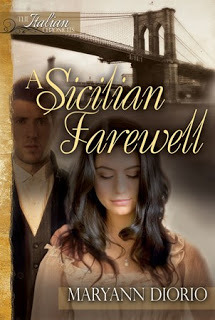 A young man, a new land, and a dream that threatens to destroy him and his family . . .
A young man, a new land, and a dream that threatens to destroy him and his family . . .The dream of a better life for himself and his family drives Luca Tonetta to the American Promised Land with his wife of five years, Maria Landro Tonetto, and their three children. But the new Promised Land is nothing like what Luca had imagined. Forced to live in a roach-infested tenement house in the seedy section of Brooklyn, he faces the hardships, prejudice, and slanderous assaults of an Italian immigrant torn between two worlds. When Luca is accused of a crime he did not commit, he learns that a dream must first die before it can live.
“Such lovely writing–and an even lovelier story! Author MaryAnn Diorio takes her readers on a courageous journey, from the ancient romance of the Old Country to the perils and possibilities of the New Country. Well developed characters and a story that will stay with you long after you’ve finished this enjoyable read.”Kathi Macias, Award-Winning Author
AMAZON | BARNES AND NOBLE
Return to Bella Terra
A mother, her son, and the man who threatens to come between them . . .

When Maria Landro Tonetta receives word that Mama is terminally ill, Maria travels to her Sicilian homeland with her son Nico. She finds herself yearning for the life she once knew as a child on Bella Terra, the family farm, now on the verge of bankruptcy. Caught between two worlds, Maria dreams of moving back to Sicily with her husband and children to save the farm. When Nico’s biological father unexpectedly appears at Mama’s funeral, Maria faces a new enemy to her dream. But is there an even greater enemy within her own soul?
“Each book in the Italian Chronicles series made me want to read the next one. Now I would like to see another spin-off series dealing with the next generation. The characters in MaryAnn Diorio’s book feel so real. They have flaws. They seek better relationships. They suffer and they rejoice. Just like us. There are people in their lives who help strengthen their faith, and there are those who undermine their faith. In this third book, Maria has to face letting go of many things, and only through seeking God first can she do that. Along with messages of faith and family, Return to Bella Terra takes you to Italy, and the vicarious experience is wonderful. Diorio sprinkles just enough Italian words (in italic) throughout the text to give you the sense of being there. You can smell the food, hear the music, and see the beautiful countryside. I highly recommend this series and any other books written by MaryAnn Diorio.” Claudia Cuddy, Former Professor of Communications
AMAZON | BARNES AND NOBLE
p.p1 {margin: 0.0px 0.0px 0.0px 0.0px; font: 19.0px Georgia; color: #3c2314; -webkit-text-stroke: #3c2314} p.p2 {margin: 0.0px 0.0px 0.0px 0.0px; font: 13.0px Helvetica; color: #3c2314; -webkit-text-stroke: #3c2314} span.s1 {font-kerning: none} THE MADONNA OF PISANO BY MARYANN DIORIOPublication Date: December 15, 2015TopNotch PressPaperback & eBook; 310 PagesSeries: The Italian Chronicles, Book OneGenre: Historical Fiction/Religious
A SICILIAN FAREWELL
BY MARYANN DIORIO
Publication Date: December 14, 2016TopNotch PressPaperback & eBook; 258 PagesSeries: The Italian Chronicles, Book Two p.p1 {margin: 0.0px 0.0px 0.0px 0.0px; font: 19.0px Georgia; color: #3c2314; -webkit-text-stroke: #3c2314} p.p2 {margin: 0.0px 0.0px 0.0px 0.0px; font: 13.0px Helvetica; color: #3c2314; -webkit-text-stroke: #3c2314} span.s1 {font-kerning: none} Genre: Historical Fiction/Religious
RETURN TO BELLA TERRABY MARYANN DIORIOPublication Date: October 26, 2017TopNotch PressPaperback & eBook; 242 PagesSeries: The Italian Chronicles, Book Three p.p1 {margin: 0.0px 0.0px 0.0px 0.0px; font: 19.0px Georgia; color: #3c2314; -webkit-text-stroke: #3c2314} p.p2 {margin: 0.0px 0.0px 0.0px 0.0px; font: 13.0px Helvetica; color: #3c2314; -webkit-text-stroke: #3c2314} span.s1 {font-kerning: none} Genre: Historical Fiction/Religious
Published on March 08, 2018 23:00
March 7, 2018
#NewRelease ~ The Cursed Wife by Pamela Hartshorne #HistoricalFiction @PamHartshorne
The Cursed Wife
by Pamela Hartshorne
Secrets and lies in Elizabethan London

As a small girl, Mary was cursed for causing the death of a vagrant child, a curse that predicts that one day she will hang. But now she is sure the curse has been broken. She has tried so hard to be good, and has been rewarded with a happy marriage to a wealthy merchant, living a charmed life in Elizabethan London.
But one rainy day in Cheapside, her past catches up with her in the shape of Cat, once her mistress and now to be her maid.
Published by Pan Macmillan on 8 March 2018, The Cursed Wife is a page-turning, psychological thriller set in Elizabethan London.
Amazon Book Depository Waterstones
Pamela Hartshorne
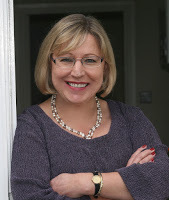 After a haphazard career working and travelling around the world, Pamela first stumbled into writing as a way to fund a Ph.D. in Medieval Studies at the University of York. Twenty years, 60 romances and one Ph.D. later, she stepped out of her comfort zone and began writing 'time slip' novels that drew on her research into the Elizabethan street and her fascination with the relationship between the past and the present.
After a haphazard career working and travelling around the world, Pamela first stumbled into writing as a way to fund a Ph.D. in Medieval Studies at the University of York. Twenty years, 60 romances and one Ph.D. later, she stepped out of her comfort zone and began writing 'time slip' novels that drew on her research into the Elizabethan street and her fascination with the relationship between the past and the present.Time’s Echo, published by Pan Macmillan in 2012, was her first mainstream novel. It was followed by The Memory of Midnight, published in 2013, The Edge of Dark in 2014 and House of Shadows in 2016. Her next novel, The Cursed Wife, a psychological thriller set in Elizabethan London, is released on 8 March 2018.
Pamela lives in York and in addition to writing fiction, she is also a project editor and a writer of non-fiction, most recently a history of Windsor Castle.
More information about Pamela can be found on her website, her Facebook page or on Twitter. She is always glad to hear from readers and fellow history enthusiasts.
Published on March 07, 2018 23:00
March 6, 2018
Author’s Inspiration ~ Beryl Kingston #HistFic #HistoricalFiction @berylkingston
Please give a warm welcome to Historical fiction author, Beryl Kingston. Bery is going to share her inspiration behind her fabulous book, Everbody's Somebody.
Author’s InspirationI have to admit I cheated over this book, because I began by trawling back into my own family history, not because I wanted to search out all my long-lost relations but because of three of the people I grew up with. All three of them had very interesting tales to tell and I sat at their feet as a very young child with my ears flapping and afterwards and in secret wrote up everything I could remember of what they said in my well hidden, very secret, diary.
One of them whose name was Jesse Garnsworthy, had been a soldier in the First World War and served in the trenches for the full four years, I heard things from him that I’d never heard before and have never seen in any history book. One of them was the ‘morning hate’ which I’ve described in the book exactly as it was described to me but he also told me about the food, the rats, the lice and the general filth of the trenches. Respec’ Jesse.
The second one was Jesse’s wife whose name was Minnie but whom I always called Dardy because Garnsworthy was too difficult for my infant tongue and the nickname stuck. She told me almost casually that she had been sent out to work the day after her twelfth birthday, I was absolutely horrified to hear it and thought how cruel it was, but she said that was the way things were in the old days and they all had to put up with it. I loved her to bits. She was the most hardworking and loving woman I’ve ever met, she worked every day of her life, from twelve years old until the day before she died when she was in her eighties. And she became my heroine as she always was. Respec’ Dardy.

PICTURE OF DARDY – WIFE’S NAME IS MINNIE.
The third, was an Aunt called Vera Dawson and she (Respec’ again!) was a Suffragette who chained herself to the railings in Parliament Square and of course was arrested, she told me how Suffragettes were despised and openly abused especially by what she called ‘rough-necks’, so there’s another thread for my book and again it was verbatim.
Beryl Kingston
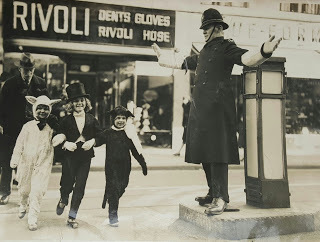 I was born in 1931 in Tooting, and when I was four was enrolled at a local dancing school run by a lady called Madam Hadley, which I attended until I was eight when the war began. Because of the war my school career was – shall we say – varied. I was evacuated twice, the first time to Felpham which is near Bognor Regis and the second to Harpenden in Hertfordshire, and consequently went to ten different schools. I ended up at Streatham Secondary School, an LCC grammar run on the Dalton system, which offered a few lessons as sparking points and then required pupils to be responsible for their own learning, either in study rooms with their teachers on hand to help and advise, or on their own in the library or the school hall. It suited me to a T. Then to King’s College London, where I read English and enjoyed myself a lot, but wasn’t particularly distinguished, having other things on my mind by then.
I was born in 1931 in Tooting, and when I was four was enrolled at a local dancing school run by a lady called Madam Hadley, which I attended until I was eight when the war began. Because of the war my school career was – shall we say – varied. I was evacuated twice, the first time to Felpham which is near Bognor Regis and the second to Harpenden in Hertfordshire, and consequently went to ten different schools. I ended up at Streatham Secondary School, an LCC grammar run on the Dalton system, which offered a few lessons as sparking points and then required pupils to be responsible for their own learning, either in study rooms with their teachers on hand to help and advise, or on their own in the library or the school hall. It suited me to a T. Then to King’s College London, where I read English and enjoyed myself a lot, but wasn’t particularly distinguished, having other things on my mind by then.I am proud of the fact that I was in Tooting for the first four months of the blitz, and only left it to be evacuated again when our road was bombed and our house was uninhabitable. I spent the middle part of the war in Harpenden and returned to live in London again at the end of the war at the time of the V2’s, this time without my family.
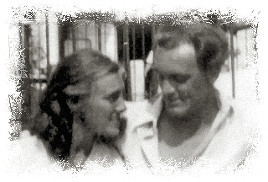 When I was just sixteen I met the love of my life, who arrived on my doorstep in Air Force blue one February evening in the coldest winter on record.
When I was just sixteen I met the love of my life, who arrived on my doorstep in Air Force blue one February evening in the coldest winter on record.Despite heavy opposition from my parents, we married three years later during my first year at King’s and spent the next 53 years 11 months and 6 days living more and more happily together.
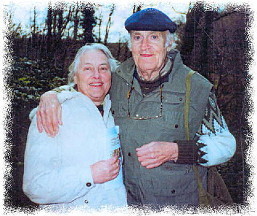 We had three much loved children and five much loved grandchildren and once I’d embarked on my career as a novelist, researched all the books together, which was great fun. We finished work on ‘Gates of Paradise’ six weeks before he died. So this publication is special to me.
We had three much loved children and five much loved grandchildren and once I’d embarked on my career as a novelist, researched all the books together, which was great fun. We finished work on ‘Gates of Paradise’ six weeks before he died. So this publication is special to me.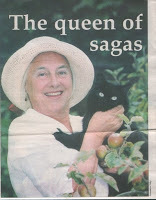 I have enjoyed two careers in my life – as a teacher from 1952 to 1985 (with ten years off to bring up my family, which some might consider a third career) and as a published writer from 1980 to date. I am also, although it sounds immodest to say it, an easy and charismatic public speaker, usually unfazed by any audience no matter how big or how small or what questions they might throw at me.
I have enjoyed two careers in my life – as a teacher from 1952 to 1985 (with ten years off to bring up my family, which some might consider a third career) and as a published writer from 1980 to date. I am also, although it sounds immodest to say it, an easy and charismatic public speaker, usually unfazed by any audience no matter how big or how small or what questions they might throw at me.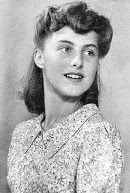 In the two schools where I was head of the English department, I deliberately covered the full range of age and ability, believing that as I was paid the largest salary I should carry the heaviest responsibility. My work was filmed by KCL Education Department for use in their PGCE course and I have given talks at various colleges and schools on a variety of educational subjects, from teaching poetry to ‘tackling’ sex education. I have never subscribed to the Gradgrind theory of education which is current now, but always believed that the job of a teacher is to enable her students to learn.
In the two schools where I was head of the English department, I deliberately covered the full range of age and ability, believing that as I was paid the largest salary I should carry the heaviest responsibility. My work was filmed by KCL Education Department for use in their PGCE course and I have given talks at various colleges and schools on a variety of educational subjects, from teaching poetry to ‘tackling’ sex education. I have never subscribed to the Gradgrind theory of education which is current now, but always believed that the job of a teacher is to enable her students to learn.I have always been a political animal, taking part in street demonstrations, walking from Aldermaston to London, involved in the 1945 election despite the fact that I was only fourteen, taking to the streets again, along with a million others, to protest against the Iraq war when I was 72. And as a last and rather lighter touch, I was a beauty queen in 1947. It wasn’t all protests!
<!-- /* Font Definitions */ @font-face {font-family:Times; panose-1:2 0 5 0 0 0 0 0 0 0; mso-font-charset:0; mso-generic-font-family:auto; mso-font-pitch:variable; mso-font-signature:3 0 0 0 1 0;} @font-face {font-family:"MS 明朝"; mso-font-charset:78; mso-generic-font-family:auto; mso-font-pitch:variable; mso-font-signature:-536870145 1791491579 18 0 131231 0;} @font-face {font-family:"Cambria Math"; panose-1:2 4 5 3 5 4 6 3 2 4; mso-font-charset:0; mso-generic-font-family:auto; mso-font-pitch:variable; mso-font-signature:-536870145 1107305727 0 0 415 0;} @font-face {font-family:Cambria; panose-1:2 4 5 3 5 4 6 3 2 4; mso-font-charset:0; mso-generic-font-family:auto; mso-font-pitch:variable; mso-font-signature:-536870145 1073743103 0 0 415 0;} /* Style Definitions */ p.MsoNormal, li.MsoNormal, div.MsoNormal {mso-style-unhide:no; mso-style-qformat:yes; mso-style-parent:""; margin:0cm; margin-bottom:.0001pt; mso-pagination:widow-orphan; font-size:12.0pt; font-family:Cambria; mso-ascii-font-family:Cambria; mso-ascii-theme-font:minor-latin; mso-fareast-font-family:"MS 明朝"; mso-fareast-theme-font:minor-fareast; mso-hansi-font-family:Cambria; mso-hansi-theme-font:minor-latin; mso-bidi-font-family:"Times New Roman"; mso-bidi-theme-font:minor-bidi;} .MsoChpDefault {mso-style-type:export-only; mso-default-props:yes; font-family:Cambria; mso-ascii-font-family:Cambria; mso-ascii-theme-font:minor-latin; mso-fareast-font-family:"MS 明朝"; mso-fareast-theme-font:minor-fareast; mso-hansi-font-family:Cambria; mso-hansi-theme-font:minor-latin; mso-bidi-font-family:"Times New Roman"; mso-bidi-theme-font:minor-bidi;} @page WordSection1 {size:612.0pt 792.0pt; margin:72.0pt 90.0pt 72.0pt 90.0pt; mso-header-margin:36.0pt; mso-footer-margin:36.0pt; mso-paper-source:0;} div.WordSection1 {page:WordSection1;} </style></div><div class="MsoNormal" style="text-align: center;"><span style="background: white; color: blue; font-family: "times new roman"; font-size: 28.0pt;"><br /></span><span style="background: white; color: blue; font-family: "times new roman"; font-size: 28.0pt;">Everybody's Somebody</span><span style="font-family: "times"; font-size: 28.0pt;"><o:p></o:p></span></div><div class="MsoNormal" style="line-height: normal; text-align: left;"><span style="font-family: "times new roman"; font-size: 14.0pt;"><br /></span></div><div class="MsoNormal" style="line-height: normal; text-align: left;"><span style="font-family: "times new roman"; font-size: 14.0pt;"><br /></span><br /><div align="center" class="MsoNormal" style="line-height: normal; text-align: center;"><div class="separator" style="clear: both; text-align: center;"><a href="https://1.bp.blogspot.com/-JB16_CT_Dr..." imageanchor="1" style="clear: left; float: left; margin-bottom: 1em; margin-right: 1em;"><img border="0" data-original-height="640" data-original-width="426" height="320" src="https://1.bp.blogspot.com/-JB16_CT_Dr..." width="213" /></a></div><span style="font-family: "times new roman"; font-size: 14pt;">This is the story of a girl who is sent out to work on the day after her twelfth birthday in 1908, to a big house a long way away from her family, as many girls were in those days.<o:p></o:p></span></div><span style="font-family: "times new roman"; font-size: 14.0pt;"></span><br /><div align="center" class="MsoNormal" style="line-height: normal; text-align: center;"><span style="font-family: "times new roman"; font-size: 14pt;">It follows her from Binderton to Arundel and then wherever jobs take her, to the RAC club in London, to the Borough where she lives in Newcomen Street and discovers the suffragette movement and meets and falls in love with a Docker called Jim. The First World War pulls them apart and we follow him into the trenches and when he is wounded to the Military hospital in Tooting. Some years later when she is married and has a daughter she finds a job as an artist’s model in Cheyne Walk and as a bit-part player in Alexander Korda’s new film ‘The private life of Henry VIII’. It’s a hardworking but eventful life.</span></div></div><br /><br /><div style="text-align: center;"><span style="font-size: x-large;"><a href="https://www.amazon.com/Everybodys-Som... US</a> <a href="https://www.amazon.co.uk/Everybodys-S... UK</a></span><br /><br /><br /><br /></div>
Published on March 06, 2018 23:00
March 5, 2018
Life in the time of Anne Howard (An Unconventional Officer) by Lynn Bryant #HistoricalFiction #Regency @LynnBry29527024
Life in the time of Anne Howard (An Unconventional Officer)by Lynn Bryant
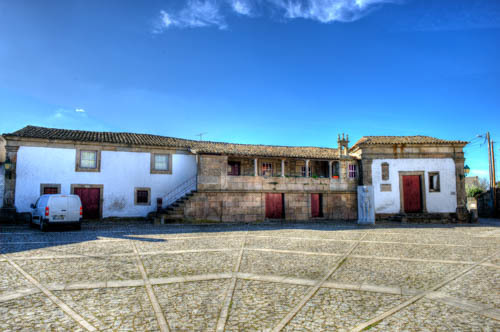
Wellington’s headquarters in Freineda, Portugal
Anne Howard, the fictional heroine of the Peninsular War Saga, was born in the small Yorkshire town of Thorndale in 1791. She was the youngest of the four children born to a wealthy textile manufacturer, Matthew Howard, who rose from humble beginnings to become the wealthiest man in the Thane valley. Anne’s mother died giving birth to her and she was raised by her stepmother, Harriet, who came from a family of Leicestershire gentry.Socially, Anne came from the wealthy middle class of the industrial revolution although her family, partly because of their wealth and partly because of her stepmother’s more genteel background, were beginning to move up the social ladder. Sir Matthew remained very much a manufacturer but his eldest son George had political ambitions and was about to step into the shoes of Mr Benjamin Carlyon, the local MP who was retiring. The move would take him to London and into a world outside the restricted society of Thorndale. Katherine, Anne’s older sister was also about to make a very good marriage to a man holding a minor government post and she too is moving up.Anne’s role was supposed to be to make a good marriage and she was offered a selection of suitors, each one of whom would bring some advantage to her family. In particular, her father favoured Lieutenant Robert Carlyon who had little money but could bring his father’s support to George’s political ambitions. Sir Matthew and Lady Howard were affectionate, if somewhat exasperated parents, and were willing to offer their wayward daughter a limited choice of husband although they were very keen to see her settled young. This was by no means general in Regency times where girls would often not marry until they were in their twenties, but one suspects that the Howards were slightly anxious about Anne’s independent spirit and were hoping to see her settled with the right man before she did something outrageous which would spoil her chances of a good match. They were probably right.We meet Anne part way through book one at the age of seventeen when she runs into the married Paul van Daan in the middle of a snowstorm. The attraction between the couple is immediate but by the end of a long day snowbound in a shepherd’s hut, it is clear that there is a lot more to the lovely Miss Howard than a pretty face and Major van Daan is a lost man.In 1808 the battle for equality for women had barely begun. Mary Wollstonecraft published “A Vindication of the Rights of Women” in 1792, which argued that women ought to have an education suited to their position in society and that they should be treated as human beings rather than property or ornaments. Women in the late eighteenth and early nineteenth century had very few rights. They could not inherit property or money unless there were no male heirs. Within marriage, women had no legal identity of their own and their husbands controlled every aspect of their lives. Divorce was not a possibility for a woman; it was difficult for a man unless he was very wealthy. A girl moved from the control of her father to that of a husband and there were virtually no respectable career opportunities for women. Certainly there were no women doctors; the first woman to graduate from medical school was Elizabeth Blackwell in the USA 1849 and Elizabeth Garrett Anderson in the UK did not graduate until 1862.In the restricted world of her time, Anne Howard was out of place and she knew it. Well-read and highly intelligent, she had been allowed a good deal of freedom in her education by her indulgent stepmother who was aware that despite the limitations of her gender she was academically ahead of both her older brothers. At the same time, it was always understood that despite her remarkable qualities, Miss Anne Howard was destined for the traditional feminine career of a useful marriage which would bring advantage to her family. Anne both accepted and resented her position in the world but had she not met Paul van Daan she might well have made the conventional marriage expected of her and made the best of it.Anne’s love affair with Paul and her subsequent marriage to Lieutenant Robert Carlyon changed everything for Sir Matthew Howard’s unconventional daughter. Taken from her Yorkshire home to the army camps of Portugal she discovered a side to herself she could never have suspected. Boredom led her to volunteer to help with the nursing at the army hospital and under the tuition of Dr Adam Norris she began to learn surgical skills, encouraged by the somewhat eccentric army surgeon who was desperate for help in the overcrowded and understaffed field hospitals. Under the disapproving eye of many of the established army surgeons she worked alongside Norris throughout the war, a doctor in everything but name, her unofficial role protected by the support of Lord Wellington and Sir James McGrigor, the head of the army medical service. In civilian life she would never have been allowed to continue but in the desperate conditions of wartime her usefulness outweighed convention and her second husband was deeply proud of her achievements.Anne is one of my favourite characters. As a historical novelist it is always important to know the restrictions and conventions of the time but it is equally fun to research the men and women who stepped outside them. There were many women who followed Wellington’s army to be with their men, from the humblest camp followers and wives of enlisted men, dragging their meagre baggage and their children through appalling conditions to the wives of officers, searching through the dead and wounded after a battle for their missing husband. They are often seen as a footnote in history, which writes of the glory and the tragedy of battle and forgets each individual tragedy of a child lost to camp fever or a husband or lover dead in the breaches at Badajoz. Juana Smith, the young Spanish wife of Harry Smith of the rifles, followed her husband throughout the war, through the most appalling conditions at times and her story, which I first read as a teenager in Georgette Heyer’s The Spanish Bride and later in Smith’s highly entertaining autobiography, was one of the inspirations behind Anne’s character in An Unconventional Officerand the rest of the Peninsular War Saga.Life in the times of Anne Howard offered few opportunities for a gently-bred middle class girl to step outside the limitations of her class and her gender but trapped in an unhappy marriage and a long way from home, Anne seized every opportunity with both hands. By the end of book one, the unconventional officer of the book’s title had found himself an unconventional woman to share his life and their extraordinary love story is at the heart of the Peninsular War Saga.
Lynn Bryant
 Lynn Bryant was born and raised in London's East End. She studied History at university and had dreams of being a writer from a young age. Since this was clearly not something a working class girl made good could aspire to, she had a variety of careers including being a librarian, NHS administrator, relationship counsellor and manager of an art gallery before she realised that most of these were just as unlikely as being a writer and took the step of publishing her first book.
Lynn Bryant was born and raised in London's East End. She studied History at university and had dreams of being a writer from a young age. Since this was clearly not something a working class girl made good could aspire to, she had a variety of careers including being a librarian, NHS administrator, relationship counsellor and manager of an art gallery before she realised that most of these were just as unlikely as being a writer and took the step of publishing her first book.She now has eight novels published on Amazon including the first four books in the Peninsular War Saga. Her ninth book, An Unwilling Alliance is set during the Copenhagen campaign of 1807 and will be the first to feature Captain Hugh Kelly RN as well as Major Paul van Daan from the Peninsular War novels.
She now lives in the Isle of Man, is married to a man who understands technology, which saves her a job, and has two teenage children and two labradors. History is still a passion, with a particular enthusiasm for the Napoleonic era and the sixteenth century. When not writing she spoils her elderly dogs, reads anything that's put in front of her and makes periodic and unsuccessful attempts to keep a tidy house.
Lynn loves to hear from readers. You can find her: Website Twitter Facebook
An Unconventional Officer (Book 1 of the Peninsular War Saga)
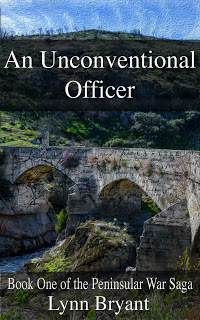 It is 1802. Bonaparte’s armies are sweeping through Europe and Britain is at war on land and at sea when two new officers arrive at the barracks of the 110th infantry just in time to join the light company on its way to fight in India under an ambitious young general called Arthur Wellesley. Junior officers have come and gone in the 110th but none of them have been quite like Paul van Daan, a man with a past and a whole new view of army life which is to change the 110th into a regiment like no other.Ambitious and unconventional with a fiery temper and a fierce courage, Paul van Daan is a man destined to go far in Wellesley’s army; a man who inspires both loyalty and envy and the love of two very different women.As Portugal and Spain are consumed by war, an unforgettable love story is set in motion...Amazon US Amazon UK
It is 1802. Bonaparte’s armies are sweeping through Europe and Britain is at war on land and at sea when two new officers arrive at the barracks of the 110th infantry just in time to join the light company on its way to fight in India under an ambitious young general called Arthur Wellesley. Junior officers have come and gone in the 110th but none of them have been quite like Paul van Daan, a man with a past and a whole new view of army life which is to change the 110th into a regiment like no other.Ambitious and unconventional with a fiery temper and a fierce courage, Paul van Daan is a man destined to go far in Wellesley’s army; a man who inspires both loyalty and envy and the love of two very different women.As Portugal and Spain are consumed by war, an unforgettable love story is set in motion...Amazon US Amazon UKp.p1 {margin: 0.0px 0.0px 0.0px 0.0px; font: 12.0px Helvetica; color: #00afcd; -webkit-text-stroke: #00afcd} span.s1 {font-kerning: none}
Published on March 05, 2018 23:00
March 4, 2018
Life in the time or Harold Godwinson by G.K. Holloway #History #AngloSaxon @GlynnHolloway
Life in the time or Harold Godwinson by G.K. Holloway
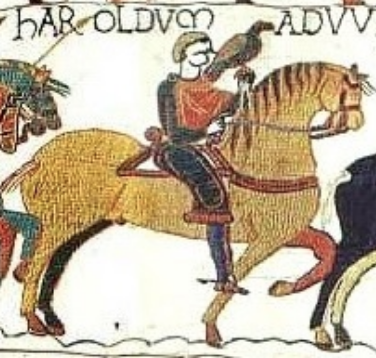 Harold Godwinson, from the Bayeux Tape
Harold Godwinson, from the Bayeux TapeIs there a time in history you’d like to visit? Is there some historical event at which you’d love to be present, or perhaps, famous people from the past who you’d like to invite to your dinner party? I have a list that’s endless, but of all the people I’d like to meet, Harold Godwinson is top of the list. Anyone who’s read my book, 1066 What Fates Impose, or short story, The Battle of London Bridge, won’t be surprised by to hear that, but rather than be present at the Battles of Hastings or Stamford Bridge, I’d most like to be present on his ship during the return journey from Normandy in 1064. Why? Because I think Harold would have some very interesting things to say.
Earlier that year a messenger had arrived at the English court informing King Edward that Wulfnoth Godwinson and Haakon Sweinson, Earl Harold’s brother and nephew, had fallen into the hands of Duke William of Normandy. Both had been abducted by William de Jumieges in 1052, when they were young boys. Harold determined to bring them home. And so, sometime in the summer of 1064, Harold set sail for Normandy with a view to securing the release of his kin.
It’s a short sea journey from Bosham, in Sussex, to Normandy. Even in the eleventh century, with a good following wind, the crossing would only entail an overnight sail. When Harold left port it was after waiting out a storm that had raged for two days. After the storm the weather was calm and so there was little chance of more bad weather. There shouldn’t have been a problem crossing the Channel. There wasn’t. It was when Harold’s ship had almost completed its journey that the trouble started. Ships appeared, bore down on him and drove him onto a beach in Ponthieu, where he would become the prisoner of Count Guy, until Duke William had him released. So, before he had even met William, Harold had become indebted to him.
Once in Normandy, as the Duke’s ‘guest’ Harold would, as required by feudal custom, have to stay for forty days. As William’s guest, Harold joined in an expedition into Brittany where he saved the lives of a couple of Norman soldiers. Two infantrymen had fallen into quicksand and Harold dragged them free. Again, during the Brittany campaign, Harold distinguished himself with his courage and Duke William ‘rewarded’ him for his bravery by knighting him. This sounds like an honour but the downside was Harold thereby became William’s vassal and all that that entailed.
Returning to Normandy from Brittany, Harold was allowed to see his brother and nephew, but only from a distance and at a ceremony where he was to pledge his loyalty to Duke William. Harold was tricked into swearing an oath to help secure the English throne for William. Only then was Harold allowed to return home with his nephew but not his brother.
So, the scene is set. An English earl, subregulus to an aging king, in a country with no real successor to the throne, is heading home after promising to assist a foreign nobleman in his bid to become the next King of England. How would you have felt if you were Harold?
Harold, apparently, was outraged by William’s temerity. Can you visualize him ranting and raving before finally calming down? Asking the question, ‘what have I done?’ The realisation falling upon him, by trickery, a rival for the throne had recruited him to his side. ‘Why am I so gullible?’ must have been another question that ran through his mind.
I can see him pacing up and down the ship’s deck, muttering to himself, his crew wary of his mood. Eventually, his anger subsides and once he has calmed down and composed himself, he starts thinking things through. Asking himself more questions; ‘What have I done?’ must have given way to, ‘Is the oath valid?’
Then, as he weighs up the situation, a light of hope shines through the darkness. ‘Not to worry; William’s claim must be invalid. How could he possibly succeed Edward? According to Norman law, the right of succession runs down the male line only, through the first born son – primogeniture. William claims the English crown because he is the great nephew of Queen Emma. Obviously, his claim is invalid.’
Harold also knows that according to English law, the king has to be elected by the Witanagemot, or Great Council. If the king should live long enough, Edgar the Atheling would most likely be elected by the Witan. Should that not be the case, Harold himself is the most likely choice. Harold is reassured by the knowledge that William’s claim that King Edward has named him as his successor can easily be dismissed, as no English King has the right to do this without the formal agreement of the Witan.
Harold plans to discuss all this with the king. I can see calm settling over him as he decides, ‘William might be something of a problem but nothing I can’t handle. I can discuss this with the king. Time is on our side. What can he do? England is far bigger than Normandy in size and population; William doesn’t even have a navy.’ This knowledge reassures him.
From then on the crossing back to England is a quiet one. After his earlier outburst, Harold is relaxed. He has thought matters through. What appeared to be an enormous problem is really just a snag that can be dealt with in due course.
As I sit there observing, I know Harold isn’t aware of how events will unfold over the next two years. Three Northumbrians’ with designs of their own will disappear or be found dead. Tostig, Harold’s brother and Earl of Northumbria, will be overthrown in the Northern revolt and sent into exile by the king. If that wasn’t bad enough, 1066 would begin with the death of King Edward. Later in the year, Harold would find himself married to Edith of Mercia. A hairy star, the harbinger of doom, would appear in the sky and across the Channel; Duke William would prepare an invasion force. All that, and in September, a huge Viking army would invade the North of England.
Harold is having a bad enough day as it is, should I tell him what he has in store?
G K Holloway
 After graduating from Coventry University with an honours degree in history and politics, G K Holloway worked in education in and around Bristol, where he now lives with his wife and two children. After reading a biography about Harold Godwinson, he studied the late Anglo Saxon era in detail and visited all of the locations mentioned in the sources. When he had enough material to weave together facts and fiction he produced his novel. 1066 What Fates Impose, is the product of all that research – and some imagination. A sequel is on its way.
After graduating from Coventry University with an honours degree in history and politics, G K Holloway worked in education in and around Bristol, where he now lives with his wife and two children. After reading a biography about Harold Godwinson, he studied the late Anglo Saxon era in detail and visited all of the locations mentioned in the sources. When he had enough material to weave together facts and fiction he produced his novel. 1066 What Fates Impose, is the product of all that research – and some imagination. A sequel is on its way.1066 What Fates Impose
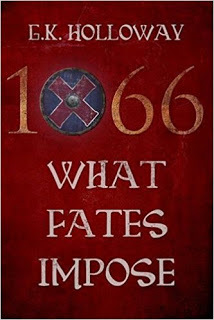 England is in crisis. King Edward has no heir and promises never to produce one. There are no obvious successors available to replace him, but quite a few claimants are eager to take the crown. While power struggles break out between the various factions at court, enemies abroad plot to make England their own. There are raids across the borders with Wales and Scotland. Harold Godwinson, Earl of Wessex, is seen by many as the one man who can bring stability to the kingdom. He has powerful friends and two women who love him, but he has enemies who will stop at nothing to gain power. As 1066 begins, England heads for an uncertain future. It seems even the heavens are against Harold. Intelligent and courageous, can Harold forge his own destiny - or does he have to bow to what fates impose?
England is in crisis. King Edward has no heir and promises never to produce one. There are no obvious successors available to replace him, but quite a few claimants are eager to take the crown. While power struggles break out between the various factions at court, enemies abroad plot to make England their own. There are raids across the borders with Wales and Scotland. Harold Godwinson, Earl of Wessex, is seen by many as the one man who can bring stability to the kingdom. He has powerful friends and two women who love him, but he has enemies who will stop at nothing to gain power. As 1066 begins, England heads for an uncertain future. It seems even the heavens are against Harold. Intelligent and courageous, can Harold forge his own destiny - or does he have to bow to what fates impose?Amazon UK Amazon US
Published on March 04, 2018 23:00
March 3, 2018
#BookReview ~ The Queen of the North by Anne O’Brien #HistoricalFiction #mustread @anne_obrien
The Queen of the North by Anne O’Brien
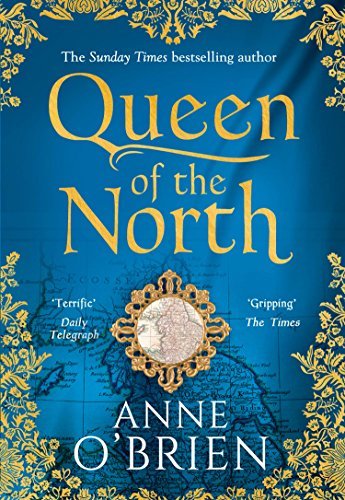
To those around her she was a loyal subject.In her heart she was a traitor.
1399: England’s crown is under threat. King Richard II holds onto his power by an ever-weakening thread, with exiled Henry of Lancaster back to reclaim his place on the throne.
For Elizabeth Mortimer, there is only one rightful King – her eight-year-old nephew, Edmund. Only he can guarantee her fortunes, and protect her family’s rule over the precious Northern lands bordering Scotland.But many, including Elizabeth’s husband, do not want another child-King. Elizabeth must hide her true ambitions in Court, and go against her husband’s wishes to help build a rebel army.
To question her loyalty to the King places Elizabeth in the shadow of the axe.
To concede would curdle her Plantagenet blood.
This is one woman’s quest to turn history on its head.
The Coffee Pot Book Club Review

"O gentlemen, the time of life is short..." Henry IV Part 1 Act V II
There was only one true King of England.Unfortunately, it wasn't the man who sat on the throne.
Elizabeth Mortimer, great-granddaughter of Edward III and wife to the celebrated Sir Harry Hotspur, wanted to see a Mortimer on the throne of England. She believed that her eight-year-old nephew, Edmund, was the true king of England. But talks of treason would lead her down a very dark and dangerous path. In her quest to right a wrong, she would risk losing everything and everyone she had ever loved.
There are some books that you read, and then you have to stand back and take a moment to think about what you have just read. The Queen of the North by Anne O'Brien is such a book. I still have tears in my eyes as I write this review. The story is poetically tragic. There are no winners. Just an unmarked grave in York Minster.
The Queen of the North begins at the end of King Richard II's reign and continues through the turbulent years of Henry IV's as he battles to keep the crown upon his head. Elizabeth Mortimer, whose life this story follows, has everything. She has Plantagenet blood running in her veins. She is married to a great man, Henry Percy, whom she adores. She is, to all intents and purposes, the Queen of the North of England. The Percy family have wealth, position, and power. With the coronation of Henry IV, the Percy's became known as the Kingmakers, for they helped to put Henry where he was. But although Henry IV is Elizabeth's cousin, his claim to the throne does not rest comfortably with her. She is determined to see her nephew, Edmund, take up his rightful inheritance, and she will stop at nothing to see this come to pass.
Kudos, Ms O'Brien because I was utterly swept away by this story and I found myself wanting the impossible. I wanted history to be rewritten. I wanted a different outcome — that is how much I grew to care for these characters. They were no longer names in a history book. They were real, flesh and blood people. Ms O' Brien has brought them back to life.
The story is told in the first person from Elizabeth's point of view. Elizabeth was a character that I really felt for. She makes so many mistakes, and it costs her everything. She loses everything. And yet, I could not help but like her. And as for Hotspur... It was wonderful to see him portrayed the way Ms O'Brien chose to portray him. He was incredibly charismatic, larger than life, the kind of man that surely cannot die. He inspired his men, his family, everything and everyone he touched — even King Henry. It was wonderful to read about him and his achievements.
I am a big fan of Anne O'Brien's work. Her books always impress, and The Queen of the North is no exception. I loved it. If you are a fan of historical fiction, then all of Anne O'Brien's books should be on your 'to-read' list. I cannot recommend The Queen of the North enough. Fabulous!!
Available for Pre-OrderReleased 31stMay 2018 Amazon
Anne O’Brien
 Anne O’Brien was born in West Yorkshire. After gaining a BA Honours degree in History at Manchester University and a Master’s in Education at Hull, she lived in East Yorkshire for many years as a teacher of history.
Anne O’Brien was born in West Yorkshire. After gaining a BA Honours degree in History at Manchester University and a Master’s in Education at Hull, she lived in East Yorkshire for many years as a teacher of history.She now lives with her husband in an eighteenth-century timber-framed cottage in the depths of the Welsh Marches in Herefordshire, on the borders between England and Wales, where she writes historical novels. The perfect place in which to bring medieval women back to life.
Anne loves to hear from readers, you can find her: Website Facebook Twitter
Published on March 03, 2018 10:04
March 1, 2018
Life in the time of Nicholaa de la Haye, England’s Forgotten Heroine By Sharon Bennet Connolly #Medieval #History @Thehistorybits
Life in the time of Nicholaa de la Haye, England’s Forgotten HeroineBy Sharon Bennet Connolly
 Lincoln Cathedral as viewed for Lincoln Castle
Lincoln Cathedral as viewed for Lincoln CastleNicholaa de la Haye is one of those very rare women in English history. She is renowned for her abilities, rather than her family and connections. In a time when men fought and women stayed home, Nicholaa de la Haye held Lincoln Castle against all-comers. Her strength and tenacity saved England at one of the lowest points in history.
The eldest daughter and co-heiress of Richard de la Haye and his wife, Matilda de Verdun, she was probably born in the early 1150s. Richard de la Haye was a minor Lincolnshire lord; in 1166 he was recorded as owing 20 knights’ fees, which had been reduced to 16 by 1172. When he died in 1169, Nicholaa inherited her father’s land in Lincolnshire and his position as castellan of Lincoln Castle, a position she would hold for over 30 years.
Nicholaa was married twice, her first husband, William Fitz Erneis, died in 1178. Before 1185 she married Gerard de Camville, son of Richard de Camville, admiral of Richard I’s crusading fleet during the 3rd Crusade. Although her first marriage was probably childless, Nicholaa and Gerard had at least 3 children; Richard, Thomas and Matilda.
Nicholaa’s husbands each claimed the position of castellan of Lincoln Castle by right of his wife; but Nicholaa seems to have been far from the normal subservient wife. When her husband was not in the castle, she was left in charge rather than an alternative, male deputy.
Nicholaa first comes to the attention of the chroniclers in 1191, when Prince John made a play for his brother Richard’s throne. Gerard de Camville was a supporter of John and joined him at Nottingham Castle, leaving Nicholaa to hold Lincoln. Richard I’s Chancellor, William Longchamps had headed north to halt John’s coup and laid siege to Lincoln Castle.
 Lincoln Castle Walls
Lincoln Castle WallsThe formidable Nicholaa refused to yield, holding out for 40 days before Longchamps raised the siege following the fall of the castles at Tickhill and Nottingham. Amusingly, Richard of Devizes said of this defence of Lincoln Castle, that she did it ‘without thinking of anything womanly’.
In 1194, on the king’s return, Camville was stripped of his positions as Sheriff of Lincolnshire and Castellan of the castle; only having it returned to him on the accession of King John in 1199.
Gerard de Camville died around 1215 and, although now a widow, it seems the castle remained in Nicholaa’s hands. On one of King John’s visits to inspect the castle’s defences in either 1215 or 1216 there was a rather dramatic display of fealty from Nicholaa :
And once it happened that after the war King John came to Lincoln and the said Lady Nicholaa went out of the eastern gate of the castle carrying the keys of the castle in her hand and met the king and offered the keys to him as her lord and said she was a woman of great age and was unable to bear such fatigue any longer and he besought her saying, “My beloved Nicholaa, I will that you keep the castle as hitherto until I shall order otherwise”.¹
As we all know, King John’s reign wasn’t exactly smooth sailing. He lost his French lands and was held to account by the barons of England for numerous examples of maladministration, corruption and outright murder. In 1215 he had been forced to seal the Magna Carta in order to avoid war. Although it eventually came to be considered a fundamental statement of English liberties, as a peace treaty Magna Carta failed miserably. Within months John had written to Pope Innocent III and the charter had been declared null and void; the barons were up in arms.
The rebels invited the king of France to take the throne of England; instead Philip II’s son, Louis (the future Louis VIII), accepted the offer and was hailed as King of England in London in June of 1216. In the same year Nicholaa prevented another siege by paying off a rebel army, led by Gilbert de Gant, who had occupied the city of Lincoln.
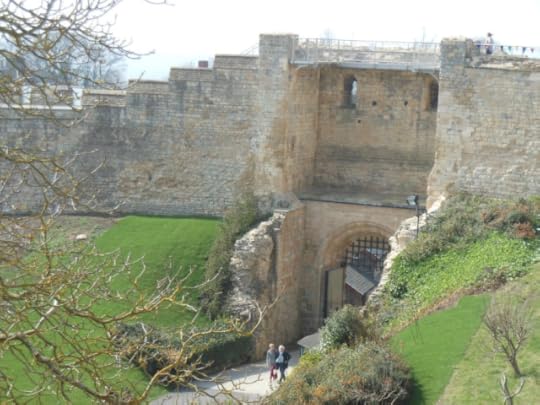 The West Gate, through which part of William Marshal’s relieving force entered Lincoln Castle.
The West Gate, through which part of William Marshal’s relieving force entered Lincoln Castle.As Louis consolidated his position in the south, John made an inspection of Lincoln castle in September 1216. During the visit Nicholaa de la Haye, who held the castle for John, even though the city supported the rebels, was appointed Sheriff of Lincolnshire in her own right.
Moving south, just 2 weeks later, the king’s baggage train was lost as he crossed the Wash estuary and within a few more days John was desperately ill.
King John died at Newark on 19th October 1216, with half his country occupied by a foreign invader and his throne now occupied by his 9-year-old son, Henry III. The elder statesman and notable soldier William Marshal, Earl of Pembroke was appointed Regent and set out to save the kingdom.
Meanwhile, Louis’ forces, under the Comte du Perche, headed north and, in early 1217, took the City of Lincoln and laid siege to the castle with a small force. Now in her 60s Nicholaa de la Haye took charge of the defences. Prince Louis personally travelled up to Lincoln to ask for her surrender, assuring her no one would be hurt, but Nicholaa refused.
When the small force proved insufficient to force a surrender, the French had to send for reinforcements. For almost 3 months – from March to mid-May – siege machinery bombarded the south and east walls of the castle. On the 20th MayWilliam Marshal arrived, from the north-west, with a relieving force. Having taken the North Gate of the city walls, his army proceeded to attack the besieging forces and routed the enemy; the enemy’s commander, the Comte du Perche, was killed in the fighting.
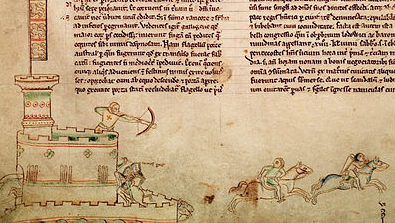 The Battle of Lincoln, 1217
The Battle of Lincoln, 1217The city, which had supported the rebels and welcomed the French, was sacked and looted by the victorious army; the battle becoming known as the Lincoln Fair, as a result.
The Battle of Lincoln turned the tide of the war. The French were forced to seek peace and returned home. Magna Carta was reissued and Henry III’s regents could set about healing the country.
In a magnificent demonstration of ingratitude, within 4 days of the relief of the Castle, Nicholaa’s position of Sheriff of Lincolnshire was given to the king’s uncle William Longspée, Earl of Salisbury, who took control of the city and seized the castle.
Not one to give up easily Nicholaa travelled to court to remind the king’s regents of her services, and request her rights be restored to her. A compromise was reached whereby Salisbury remained as Sheriff of the County, while Nicholaa held the city and the castle.
Nicholaa’s granddaughter and heiress, Idonea – daughter of Nicholaa’s eldest son Richard – was married to Salisbury’s son, William II Longspée; the couple inherited the de la Haye and Camville lands on Nicholaa’s death. The settlement was not ideal, however, and some wrangling seems to have continued until Salisbury’s death in 1226.
A staunchly independent woman, she issued some 25 surviving charters in her name. She made grants to various religious houses, including Lincoln Cathedral, and even secured a royal grant for a weekly market on one of her properties.
 Magna Carta
Magna CartaA most able adversary for some of the greatest military minds of the time, and a loyal supporter of King John, she was unique among her peers. Although praised by the chroniclers, they seemed to find difficulty in describing a woman who acted in such a fashion; the Dunstable annals refer to her as a ‘noble woman’, saying she acted ‘manfully’. One cannot fail to feel admiration for a woman who managed to hold her own in a man’s world, who fought for her castle and her home in a time when women had so little say over their own lives – and at such an advanced age. Her bravery and tenacity saved Henry III’s throne.
Not surprisingly, Henry III referred to her as ‘our beloved and faithful Nicholaa de la Haye’.
Nicholaa de la Haye, the woman who saved England, lived well into her 70s. By late 1226 she had retired to her manor at Swaton, dying there in 1230. She was buried in St Michael’s Church, Swaton in Lincolnshire.
Footnote: ¹Irene Gladwin: The Sheriff; The Man and His Office
Photos of Lincoln Castle, copyright Sharon Bennett Connolly 2015.Picture of the Battle of Lincoln and Magna Carta are courtesy of Wikipedia.
Sources: The Plantagenet Chronicles edited by Elizabeth Hallam; Brassey’s Battles by John Laffin; 1215 The Year of Magna Carta by Danny Danziger & John Gillingham; The Life and times of King John by Maurice Ashley; The Story of Britain by Roy Strong; The Plantagenets, the Kings Who Made England by Dan Jones; England Under the Norman and Angevin Kings by Robert Bartlett; lincolnshirelife.co.uk; catherinehanley.co.uk; magnacarta800th.com; lothene.org; lincolncastle.com; The Sheriff: The Man and His Office by Irene Gladwin; Elizabeth Chadwick; Nick Buckingham; swaton.org.uk.
First Published on History... The Interesting Bits 13/06/2015
Sharon Bennett Connolly
 Sharon Bennett Connolly has been fascinated by history for over 30 years now. She has studied history academically and just for fun – and even worked as a tour guide at historical sites, including Conisbrough Castle.
Sharon Bennett Connolly has been fascinated by history for over 30 years now. She has studied history academically and just for fun – and even worked as a tour guide at historical sites, including Conisbrough Castle.Born in Yorkshire, she studied at University in Northampton before working in Customer Service roles at Disneyland in Paris and Eurostar in London.
She is now having great fun, passing on her love of the past to her son, hunting dragons through Medieval castles or exploring the hidden alcoves of Tudor Manor Houses.
On launching her own blog – History ... the Interesting Bits, Sharon started researching and writing about the lesser-known stories and people from European history, the stories that have always fascinated. Quite by accident, she started focusing on medieval women. And in 2016 she was given the opportunity to write her first non-fiction book, Heroines of the Medieval World, which has recently been published by Amberley. She is now working on her second book, Silk and the Sword: the Women of the Norman Coqnquest, which will be released in late 2018.
Sharon loves to hear from readers, you can find her: Website Facebook Twitter
Heroines of the Medieval World
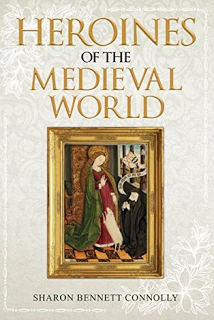 These are the stories of women, famous, infamous and unknown, who shaped the course of medieval history. The lives and actions of medieval women were restricted by the men who ruled the homes, countries and world they lived in. It was men who fought wars, made laws and dictated religious doctrine. It was men who were taught to read, trained to rule and expected to fight. Today, it is easy to think that all women from this era were downtrodden, retiring and obedient housewives, whose sole purpose was to give birth to children (preferably boys) and serve their husbands.Heroines of the Medieval World looks at the lives of the women who broke the mould: those who defied social norms and made their own future, consequently changing lives, society and even the course of history.
These are the stories of women, famous, infamous and unknown, who shaped the course of medieval history. The lives and actions of medieval women were restricted by the men who ruled the homes, countries and world they lived in. It was men who fought wars, made laws and dictated religious doctrine. It was men who were taught to read, trained to rule and expected to fight. Today, it is easy to think that all women from this era were downtrodden, retiring and obedient housewives, whose sole purpose was to give birth to children (preferably boys) and serve their husbands.Heroines of the Medieval World looks at the lives of the women who broke the mould: those who defied social norms and made their own future, consequently changing lives, society and even the course of history.Amazon US Amazon UK
Published on March 01, 2018 23:00
February 28, 2018
The Origins of Uther Pendragon by Tim Walker #Arthurian #NewRelease #HistoricalFiction @timwalker1666
Published on February 28, 2018 23:00
February 27, 2018
Author’s Inspiration ~ M.K. Tod #HistFic #WW1 @MKTodAuthor
Please give a warm Coffee Pot welcome to historical fiction author, Mary. K. Todd.
Author’s Inspiration

Each author creates and writes in her or his own way. There is no best approach; what matters most is whether in the end the story is compelling from a reader’s point of view.
The idea for my latest novel, Time and Regret, came while travelling in France with my husband to visit the battlefields, monuments, cemeteries, and museums dedicated to World War One.
On that trip, we went to Bailleul, Lille, Amiens, Ypres, Mont St. Eloi and other towns and villages, and to memorials at Vimy, Courcelette, Thiepval and Passchendaele. We visited the Musee de la Grande Guerre in Peronne. We stayed at a charming hotel that used to be a chateau and dined at its next-door restaurant. Those places and the landscape of the region engaged every sense and, along with the hundreds of pictures taken, have fuelled descriptions of meadows, villages, windows, tastes, gardens, restaurants, and other parts of Time and Regret.
Of most significance to this novel is the night we spent at a café in the small town of Honfleur across the mouth of the Seine from Le Havre. Shortly after the waiter poured our first glass of red wine, I wrote a few words in a small notebook.
“What are you writing?” Ian said.
“An idea for a story,” I replied.
Refusing to be put off by my cryptic response, he persisted. “What’s the idea?”
“Nothing much. Just thought it might make a good story to have a granddaughter follow the path her grandfather took during World War One in order to find out more about him.”
Ian took on a pensive look and no doubt had another sip of wine. “You could include a mystery,” he said.
Now, you should know that mysteries are my husband’s favorite genre. Indeed, I suspect mysteries represent at least eighty percent of his reading. So I played along. “What kind of mystery?”
And that was the birth of Time & Regret, as ideas tumbled out and the basic plot took shape. Needless to say, the bottle of wine was soon empty.
I’m drawn to the impact of war not just on individuals but also on marriages and families. I began writing my first novel, now called Unravelled, by investigating the lives of my maternal grandparents and as such, I came to see both sides – male and female – of a time with such dreadful consequences. Not only did men go to war, but women also ‘went to war’ on the home front and I wanted to share that perspective. Beyond that, I hope to tell stories that engage both men and women. Too much war and you lose the female audience; too much romance and you lose the men.
I was never a student of history and so I was startled to find researching WWI so fascinating. However, fascination was followed by anger, sorrow and bewilderment—anger at the incredible ineptitude of military and political leaders and sorrow for what soldiers and everyday citizens had to endure.
My bewilderment centered on questions of humanity. Why did soldiers put up with unspeakable conditions for so long? How could leaders use such appalling measures as poison gas? How could parents bear the loss of more than one son? How could officers send their men ‘over the top’ time after time when they knew death would greet so many? I shake my head even now. My novels honor the sacrifice, courage and endurance of the men and women who lived in those times.
M.K.Todd
 M.K. Tod is an award-winning blogger and the author of three works of historical fiction. In 2004, Mary interrupted her business career to spend a few years as an expat in Hong Kong. That life-altering experience led to a new career and passion as a writer. Mary writes for the Historical Novel Society and the Washington Independent Review of Books. She is also known for her in-depth analysis of historical fiction and international reader surveys.
M.K. Tod is an award-winning blogger and the author of three works of historical fiction. In 2004, Mary interrupted her business career to spend a few years as an expat in Hong Kong. That life-altering experience led to a new career and passion as a writer. Mary writes for the Historical Novel Society and the Washington Independent Review of Books. She is also known for her in-depth analysis of historical fiction and international reader surveys.M.K.Tod loves to hear from readers, you can find her: Blog Facebook Goodreads Website
Time and Regret
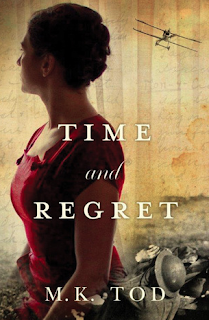 Time and Regret by M.K. Tod - When Grace Hansen finds a box belonging to her beloved grandfather, she has no idea it holds the key to his past—and to long-buried family secrets. In the box are his World War I diaries and a cryptic note addressed to her. Determined to solve her grandfather’s puzzle, Grace follows his diary entries across towns and battle sites in northern France, where she becomes increasingly drawn to a charming French man—and suddenly aware that someone is following her…
Time and Regret by M.K. Tod - When Grace Hansen finds a box belonging to her beloved grandfather, she has no idea it holds the key to his past—and to long-buried family secrets. In the box are his World War I diaries and a cryptic note addressed to her. Determined to solve her grandfather’s puzzle, Grace follows his diary entries across towns and battle sites in northern France, where she becomes increasingly drawn to a charming French man—and suddenly aware that someone is following her…Amazon US Amazon UK Indigo.ca
Published on February 27, 2018 23:00
February 26, 2018
Elizabeth Cromwell and Female Cloth Merchants in the Late Medieval Period By Carol McGrath #History #Tudors @carolmcgrath
Elizabeth Cromwell and Female Cloth Merchants in the Late Medieval PeriodBy Carol McGrath
 London Traders
London TradersThe Woman in the Shadows is set in London during the first three decades of the Tudor Era. Some historians, including myself, would consider this to be the last decades of what is known as the English Medieval period rather than this as 1485 and The Battle of Bosworth which heralded in the Tudors.Elizabeth Cromwell, wife to Thomas Cromwell who later became King Henry VIII’s chief minister, is the protagonist and heroine of The Woman in the Shadows. The novel is her story, researched from whatever sources were available. Not much was written about Elizabeth. She really was the Woman in the Shadows. However, we are told that she was the daughter of a Putney Cloth Merchant, Henry Wykes, and that it is likely her first marriage was into another cloth merchant’s family. Her second marriage to Thomas Cromwell was similar and yet different since he was a cloth middleman. He was a self-taught lawyer and at this time he took on legal work for The Merchant Adventurers. Elizabeth and Thomas married in 1514, long before Thomas Cromwell became involved in the King’s Great Matter, the dissolution of King Henry’s marriage to Katherine of Aragon.
 Drapers Sign
Drapers SignI suggest in The Woman in the Shadows that Elizabeth, by 1513/ 14, was a widowed female cloth merchant and compensate for the lack of specific knowledge about her life by researching Thomas Cromwell and the London Merchant Class, aiming to write a portrait of a woman who was firstly a widow, a merchant and wife to an ambitious man.

So what do we know about female traders during this era?It is well-known that for women, and for men also, marriage throughout the medieval period and into Tudor times could see the beginning of a new professional life. Business was often based on a partnership. A town wife’s co-operation was as important to the success of that business as that of a peasant wife working in the fields was to the labouring family’s survival. The Ordinance of Founders in 1390 stipulated that each master could have only one apprentice unless he had no wife and therefore he could have two apprentices. A wife’s contribution to the family business was therefore significant. In Elizabeth’s case, since she had an education, within the context of the novel, she kept the books for her husband’s family business. As several centuries passed since the Ordinance of Founders, more apprentices were permitted to a business and girls were often apprenticed to trades in the same way as boys. Wills written by craftsmen often leave provision for their daughters as well as their sons to be apprenticed. Girls were apprenticed to men as well as to women, though more usually female apprentices were under the tuition of the master’s wife. This makes sense since they lived in the house as part of the family.Wives and daughters were engaged in the work of the household, whatever this work was. Traditional roles did not exclude other roles. A woman could be an armourer, a merchant as is Elizabeth in my novel, a book-binder, a fletcher. Women were even found loading wool onto ships. Guild regulations which prohibited women from fully entering many trades did allow for the contribution of wives. It was her expertise that allowed her to continue her husband’s trade should she be widowed. Interestingly, sometimes women could follow a path of her own. For example, if she lived in London and some other towns such as Bath, Bristol, Lincoln, a single or married woman could become a femme sole. She would have full responsibility for managing her own business but, as such, a woman could face charges concerning her business. She could be charged, fined and go to prison, yet her husband remain untouched by law. He would not be accountable if his wife registered as a sole trader. If a business is shared, the property would by law belong to the woman’s husband who would face any charges incurred. The widow who did not remarry fulfilled many masculine roles. She could take on her husband’s name as her own or revert to her maiden surname. I allowed Elizabeth to continue as Elizabeth Williams, her dead husband’s name. A new marriage could endanger her legacy so, within the novel’s context, she was reluctant to throw away her freedom when pressed by her father to remarry. That is, until she met Thomas Cromwell and made a marriage of her own choosing. In London city law and common law combined to give the widow a good package. Legitim which usually applied to widowhood was a law of thirds, a third to the widow, a third to the children and a third part for the Church. This varied in London. In the City, by common law, legatim could be ignored. Also, Elizabeth had no children by her first husband and therefore inherited his business. Goods could be willed to the wife in the City by common law and this meant a London merchant widow could invest goods and property as she wished.A potentially wealthy widow like Elizabeth would be wooed relentlessly. Business as usual was expected, so Elizabeth carries on her husband’s cloth business. Widows were entitled to take up the freedom of the City for themselves. This was a bonus as it gave a woman the right to carry on her trade, freedom from tolls throughout England (great if you were exporting cloth through a port other than London) and she had permission to maintain her husband’s apprentices and take on others. Widows were usually regarded as ‘goodwives’ in Medieval and Tudor England. It is a term used in the novel.There was often male jealousy of the competition of female labour. No surprises there. Life could be tough for a female trader. Thus, barring women from trades (by the guilds) did happen. For example, as women’s wages were lower than a man’s for the same work men were afraid of being undercut by cheap labour. Female apprentices might not be permitted. There were women members of craft guilds, but these women were usually widows, not femmes soles, and women were rarely admitted as full members. We find women employed in all stages of cloth production from combing and carding wool, spinning of yarn, weaving though men often were found to be occupied as weavers, and female cloth merchants are, like Elizabeth Cromwell in my novel, and Chaucer’s Wife of Bath sometimes to be discovered amongst the big clothiers of England in this late medieval period. They had to be tough and frequently ruthless particularly in a competitive city such as late Medieval/early Tudor London.
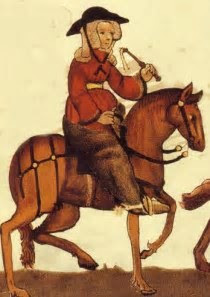 The Wife of Bath, as portrayed by Geoffrey Chaucer in the Canterbury Tales
The Wife of Bath, as portrayed by Geoffrey Chaucer in the Canterbury TalesIf you are interested in further reading I suggest:Eileen Power Medieval Women published by Cambridge University PressTudor Women by Allison Plowden published by Sutton PublishingMedieval Women by Henrietta Leyser published by Phoenix PressCarol McGrathwww.carolcmcgrath.co.uk
Carol McGrath
 From a young age my passion was reading historical novels and biography. Now I am writing them. My debut novel, The Handfasted Wife was published by Accent Press in May 2013. The Handfasted Wife is the first novel in a trilogy about the Norman Conquest from the point of view of the royal women. Its subject is Edith Swan-Neck, King Harold’s common-law / handfasted wife. The Swan Daughter and The Betrothed Sister followed in 2014 and 2015.
From a young age my passion was reading historical novels and biography. Now I am writing them. My debut novel, The Handfasted Wife was published by Accent Press in May 2013. The Handfasted Wife is the first novel in a trilogy about the Norman Conquest from the point of view of the royal women. Its subject is Edith Swan-Neck, King Harold’s common-law / handfasted wife. The Swan Daughter and The Betrothed Sister followed in 2014 and 2015.I studied for an MA at Queens University Belfast’s Seamus Heaney Centre for Creative Writing. Later I worked on the MPhil in Creative Writing at Royal Holloway, University of London. Life is not all about academic pursuits and writing books. I travel extensively, enjoy photography and love spending time with my two children, husband and our home and garden. Moreover, visits to a location here and in Europe that features in my books is the greatest excuse of all to lose oneself in the past.
Carol loves to hear from readers, you can find her: Website Twitter
The Woman in the Shadows(A standalone novel about Elizabeth Cromwell)
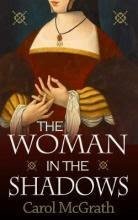 A powerful, evocative new novel by the critically acclaimed author of The Handfasted Wife, The Woman in the Shadows tells the rise of Thomas Cromwell, Tudor England's most powerful statesman, through the eyes of his wife Elizabeth.When beautiful cloth merchant’s daughter Elizabeth Williams is widowed at the age of twenty-two, she is determined to make herself a success in the business she has learned from her father. But there are those who oppose a woman making her own way in the world, and soon Elizabeth realises she may have some powerful enemies – enemies who also know the truth about her late husband.Security – and happiness – comes when Elizabeth is introduced to kindly, ambitious merchant turned lawyer, Thomas Cromwell. Their marriage is one based on mutual love and respect…but it isn’t always easy being the wife of an influential, headstrong man in Henry VIII’s London. The city is filled with ruthless people and strange delights – and Elizabeth realises she must adjust to the life she has chosen…or risk losing everything.
A powerful, evocative new novel by the critically acclaimed author of The Handfasted Wife, The Woman in the Shadows tells the rise of Thomas Cromwell, Tudor England's most powerful statesman, through the eyes of his wife Elizabeth.When beautiful cloth merchant’s daughter Elizabeth Williams is widowed at the age of twenty-two, she is determined to make herself a success in the business she has learned from her father. But there are those who oppose a woman making her own way in the world, and soon Elizabeth realises she may have some powerful enemies – enemies who also know the truth about her late husband.Security – and happiness – comes when Elizabeth is introduced to kindly, ambitious merchant turned lawyer, Thomas Cromwell. Their marriage is one based on mutual love and respect…but it isn’t always easy being the wife of an influential, headstrong man in Henry VIII’s London. The city is filled with ruthless people and strange delights – and Elizabeth realises she must adjust to the life she has chosen…or risk losing everything. Amazon US Amazon UK
Published on February 26, 2018 23:00
The Coffee Pot Book Club
The Coffee Pot Book Club (formally Myths, Legends, Books, and Coffee Pots) was founded in 2015. Our goal was to create a platform that would help Historical Fiction, Historical Romance and Historical
The Coffee Pot Book Club (formally Myths, Legends, Books, and Coffee Pots) was founded in 2015. Our goal was to create a platform that would help Historical Fiction, Historical Romance and Historical Fantasy authors promote their books and find that sometimes elusive audience. The Coffee Pot Book Club soon became the place for readers to meet new authors (both traditionally published and independently) and discover their fabulous books.
...more
...more
- Mary Anne Yarde's profile
- 159 followers




